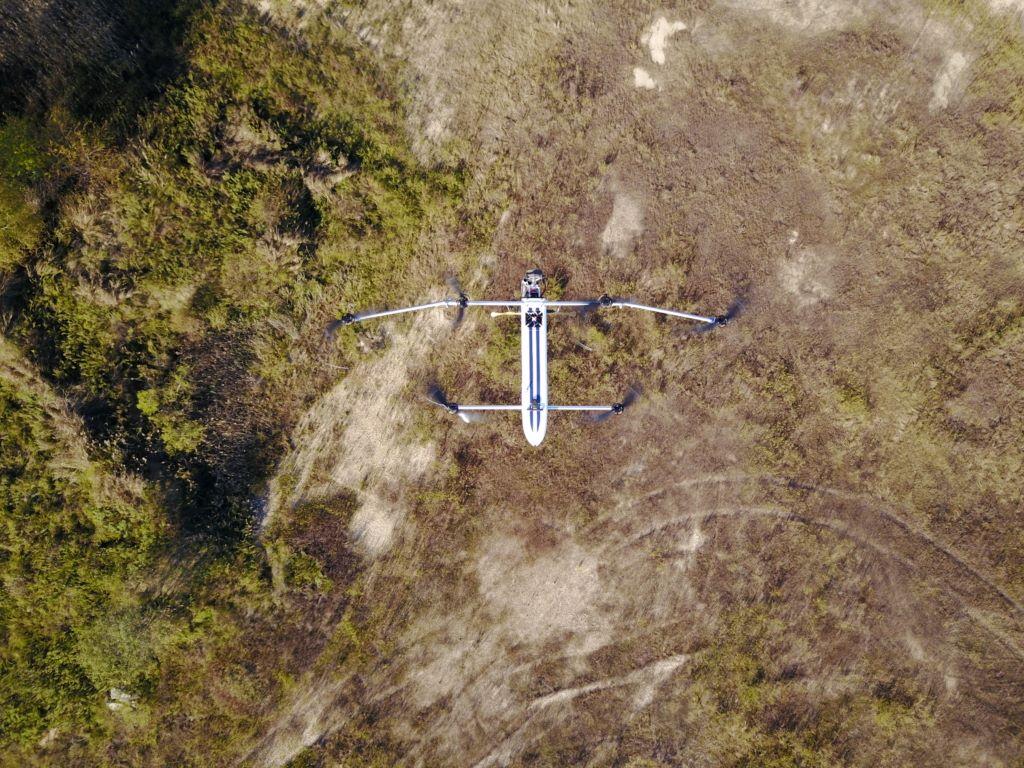
The HAMR is designed to carry a 12-lb. payload on flights up to 2 hr.
U.S. startup Advanced Aircraft Company (AAC) has secured a follow-on contract award from the U.S. Air Force’s AFWERX innovation program, providing funding to be used for the development of its hybrid-electric vertical-takeoff-and-landing (VTOL) multirotor drone.
Awarded via the AFWERX program for the development of small uncrewed aircraft systems (UAS)—part of the larger Small Business Innovation Research (SBIR) program—the $1.25 million Direct-To-Phase II contract will be used by AAC for the integration of components into its Hybrid Advanced Multi Rotor (HAMR) drone. The HAMR is designed to carry a 12-lb. payload on flights up to 2 hr., the company says.
Speaking to the AAM Report following the contract award, AAC CEO Paul Allen, who formerly held executive roles at dronemaker Insitu, outlined his vision for the HAMR. He said it would be a light and versatile long-endurance platform that can provide critical battlefield capabilities related to intelligence, surveillance and reconnaissance (ISR); search and rescue; and medical supply delivery, among other uses.
The hybrid VTOL drone is being designed to fit the mission profile for fighting near-peer adversaries in the Asia-Pacific region. This requires a focus on distributed, agile forces that can operate in hostile environments while lacking air superiority, as well as runway or charging infrastructure.
“It used to be that we would put 40,000 people on a beach and push forward, but our new adversaries have really good rocketry and targeting capabilities, so we need a new approach,” says Allen, who worked closely with the Defense Department during his time at Insitu. “Now, you have teams of 40 people that go inside the threat ring and establish temporary airfields and rearm and refuel airplanes. If you have a couple hundred of those teams, it makes targeting a dilemma for the adversary. It’s a real shell game.”
Both the Air Force and the Marine Corps have expressed interest in the HAMR, according to Allen.
“HAMR fits a really good niche for agile combat employment, as well as expeditionary advanced base operations on the Marine Corps side,” Allen says. “The Air Force want HAMR to be the tactical perimeter security unmanned system for agile combat employment … Basically, the aircraft will be looking for targets coming to harm people that set up these temporary airfields.”
AAC founder and Chief Technology Officer Bill Fredericks, a former U.S. Marine and NASA researcher, says HAMR was designed to solve two problems associated with small drones: the “atrocious” aerodynamic efficiency of multirotor aircraft, and the low energy density of battery-powered aircraft.
On the aerodynamic side, this is accomplished through a variety of methods. They include laterally staggering the layout of the fore and aft props so they do not compete for the same air inflow; spreading the props out across a wider span to reduce drag; an axial vehicle design which minimizes frontal area that is intended to reduce parasitic drag; and a slightly nose-up configuration in hover which allows the vehicle to pitch forward in cruise while still keeping the fuselage level, reducing separation drag on the bottom of the fuselage compared to typical multirotors that pitch down in forward flight.
“We’re basically doubling the aerodynamic efficiency over a conventional multirotor; our lift-to-drag ratio equivalent is similar to a single main-rotor helicopter, and yet retaining all of the benefits of a conventional multirotor,” Fredericks says.
On the propulsion side, the HAMR is distinguished by its series hybrid propulsion system, in which a fuel-injected, computer-controlled piston engine drives an integrated generator producing up to 4,000 watts to power six independent brushless DC electric motors and a backup battery.
“That really extends the range, endurance and payload capacity, which is a driving force behind our ability to carry 12 lb. for two plus hours,” Allen says. “Besides longer flight time and getting more time on target, we also can’t be dealing with big generators and battery chargers in an agile battlefield environment, so hybrid is really the only solution that makes sense.”
AAC plans to begin selling HAMR units to the Air Force in the late third quarter or early fourth quarter of this year, to be used primarily in training exercises for future combat missions.
While the company continues to develop HAMR, it also has a longer-term vision to develop a tiltwing hybrid electric VTOL aircraft based on the Greased Lighting concept that Fredericks pioneered during his time at NASA.
“Our tiltwing design has the potential to really change how we do aviation. You get the best fixed-wing performance in a VTOL aircraft with the least compromise,” Fredericks says. “When the FAA is ready, middle-mile logistics will be a massive market, and our platform will by far be the best-performing platform out there.”





